Bulletin – December 2012 Foreign Exchange Reserves and the Reserve Bank's Balance Sheet
- Download the article 273KB
Abstract
The Reserve Bank of Australia holds and manages the nation's foreign exchange reserve assets in order to meet its policy objectives. While Australia's foreign exchange reserves are relatively modest by international standards, they nonetheless constitute a sizeable portion of the Bank's balance sheet, and variations in the Australian dollar value of these reserves are usually the most volatile component of the Bank's profit and loss statement. This article discusses some of the key decisions faced by the Bank in holding and managing Australia's foreign exchange reserves, including the appropriate size of reserve holdings, the way in which they are acquired, and risk management strategies. Each of these decisions involves a trade-off between policy capacity, and financial costs and risks to the Bank's balance sheet.
Introduction
Australia, like most countries, maintains a portfolio of foreign currency reserve assets for policy and operational purposes.[1] These assets are invested on a conservative basis to facilitate these objectives, with an emphasis on liquidity and capital preservation. The majority of the nation's reserve assets (which include Australia's gold holdings) are owned and managed by the Reserve Bank of Australia, although the small proportion that constitutes Australia's reserve position in the International Monetary Fund (IMF) is held on the balance sheet of the Australian Government.[2] The Bank's mandate to manage Australia's reserve assets is established through the broad legislative powers that allow the Bank to deal in foreign exchange to achieve its monetary policy objectives. Reflecting both transactional and valuation effects, the level of Australia's reserves has tended to fluctuate in line with the exchange rate, and has averaged a little over 3 per cent of GDP since the floating of the Australian dollar in 1983 (Graph 1). Currently, the Bank's foreign exchange reserves portfolio is valued at around A$42 billion.
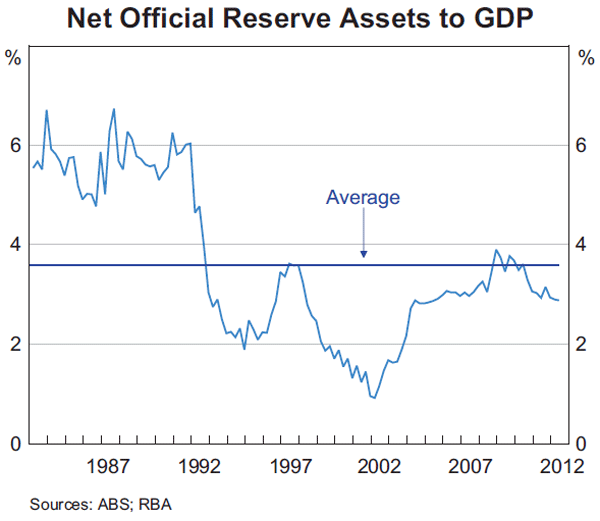
Holding foreign exchange reserve assets presents both financial and policy challenges for the Bank. While reserves can be an important tool for meeting a number of policy objectives, including the successful implementation of monetary policy, they can also generate significant balance sheet risks that are difficult to eliminate without limiting the capacity to implement policy. The most significant of these risks is an exposure to fluctuations in the value of the Australian dollar against the currencies in which reserves are held. This exposure results in valuation gains and losses from year to year. To the extent that currencies (and interest rates and credit premiums) are mean reverting, such volatility in earnings might be expected to net out over the course of an economic or currency cycle. Nonetheless, the Bank maintains a capital buffer against unexpectedly large losses in any given year or sustained losses over several years.
In three of the past four financial years, a period of heightened volatility in financial markets, the Bank's valuation gains and losses have been larger than usual in absolute terms, ranging between annual gains of more than A$6 billion and losses in excess of A$5 billion. Relative to the size of the Bank's balance sheet, the magnitude of these valuation gains and losses is large compared with the preceding decade's experience, but not especially large in comparison to experience prior to that (Graph 2).
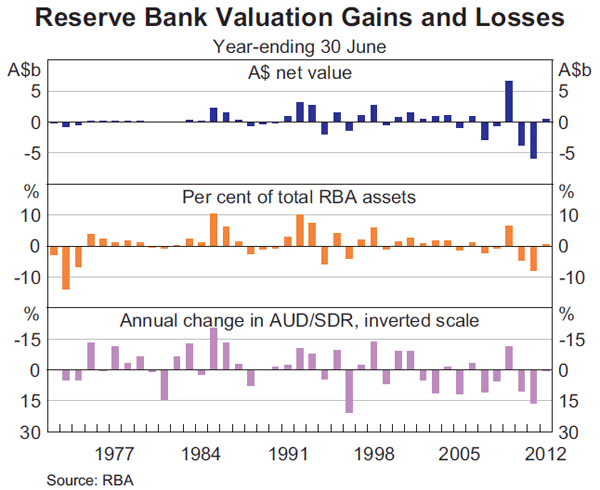
Why Hold Foreign Exchange Reserves?
The rationale for holding foreign exchange reserves differs from country to country. For a nation with a fixed exchange rate regime, a stock of liquid foreign currency assets is required to manage imbalances in the demand for, or supply of, the domestic currency, in order to maintain the exchange rate. In floating rate regimes, reserves are primarily held either to lean against exchange rate over- or undershooting and/or to intervene in periods of market dysfunction or turmoil. Under both systems, reserves can be considered analogous to an insurance policy. There is a cost to holding and managing reserves (the insurance premium), but there are potentially large payoffs in the form of improved macroeconomic outcomes and financial stability.
Australia's approach to foreign exchange intervention since the floating of the Australian dollar is discussed at length in Newman, Potter and Wright (2011). To briefly summarise, in the years immediately following the float, the purpose of intervention was to smooth out day-to-day fluctuations in the value of the Australian dollar as the foreign exchange market developed. During this period, intervention was characterised by small, frequent trades on both sides of the market. By the late 1980s, market turnover had increased significantly and hedging practices of market participants had become more sophisticated. The Bank's focus evolved to responding to episodes where the exchange rate was judged to have ‘overshot’ economic fundamentals or when speculative forces appeared to be dominating the market. This resulted in larger but less frequent interventions. Over time, the Bank's threshold for what constituted ‘overshooting’ increased as market participants (and end users) became better at managing volatility, although the Bank continued to intervene when it considered the currency to be excessively mis-priced, most notably in 2001. More recently, the motivation for intervention during the global financial crisis was severe market dysfunction.
In addition to foreign exchange intervention, reserves can also serve several other important functions. The Bank uses reserves to manage the day-to-day foreign currency requirements of the Australian Government. As these transactions occur on an almost daily basis, they form the majority of the Bank's foreign exchange transactions. Having a stock of foreign exchange allows the Bank to supply foreign currency to the government regardless of market conditions, and without affecting domestic liquidity.
The Bank also uses its reserves to assist in domestic liquidity management operations, complementing repurchase operations. Foreign exchange swaps are used to inject or remove Australian dollar liquidity by temporarily swapping Australian dollars and foreign currencies.[3] The foreign currency lent or received in the swap transaction is borrowed from, or invested in, the Bank's foreign currency reserves portfolios. Foreign exchange swaps can at times be more flexible and cost effective in adding or draining liquidity than repurchase operations.
In many emerging market economies, central banks and governments also consider reserves as useful for supporting financial systems and institutions. Recently, authorities in some developed markets have adopted a similar view. In particular, during the global financial crisis, in some countries reserves were used to provide foreign currency liquidity to banking systems, although this did not occur in Australia.
Acquiring Reserves
There are three methods through which a central bank can acquire reserves (either singularly or in combination): by borrowing foreign currency directly, for example, by issuing foreign currency securities (either in the name of the central bank or with the central government acting as an intermediary); borrowing foreign currency through the foreign exchange swap or cross-currency swap markets; or purchasing reserves outright, by selling the domestic currency in exchange for foreign currency. Borrowing foreign currency generates a hedged foreign exchange position, while outright holdings leave a central bank unhedged. The different methods have different implications for the capacity of the central bank to intervene and manage its balance sheet risk.
The Reserve Bank of Australia accrues (and replenishes) the majority of its reserves by selling Australian dollars over time, and by reinvesting the earnings on its foreign assets. This generates a net ‘long’ or unhedged position in foreign currency.
The Bank considers the insurance characteristics of unhedged holdings to be superior to those of borrowed reserves as unhedged reserves carry little or no refinancing risk, as many of the Bank's liabilities – most notably banknotes – are effectively perpetual. Conversely, foreign currency liabilities that fund borrowed reserves must be rolled over or repaid when they mature.[4] A central bank that has intervened with borrowed reserves has entered into a ‘short’ foreign currency position, and may find rolling over or repaying its liabilities more costly if the depreciation of the domestic currency persists beyond the central bank's refinancing horizon. If a central bank instead holds unhedged reserves then it may be able to wait for the exchange rate to move higher before replenishing reserves that had previously been drawn down. A central bank that borrows to fund reserves may also need to maintain a higher level of (gross) reserves to guard against this refinancing risk.
A central bank accumulating and deploying unhedged reserves counter-cyclically should, over time, earn a capital gain from such activities, as long as exchange rates are ultimately mean reverting. Unhedged reserve assets can be considered as a long position in foreign currency (or equally, a short position in the domestic currency). A central bank builds a long foreign currency position by accumulating foreign exchange as the domestic currency rises, and it effectively ‘closes’ this position profitably when intervening against a domestic currency depreciation (by selling foreign currency). Becker and Sinclair (2004) found that the Bank made a profit of around A$5 billion in stabilising the currency during three distinct exchange rate cycles from 1983 to 2003.
The Bank borrows reserves from time to time via the foreign exchange swap market. This hedged component of reserves is usually held on a temporary basis – most often for periods of less than three months – to assist with the management of domestic liquidity. The hedged and unhedged components together constitute the Bank's gross holdings of reserves, which is consistent with the IMF measure of official reserves assets. However, the Bank considers net reserves – defined as gross reserves less reserves financed via swaps – as the relevant measure of its capacity for intervention, due to the short rollover period of the Bank's swap book.[5]
Hedged reserves financed via swaps increased significantly early in the previous decade to offset the impact on domestic liquidity of large Australian Government budget surpluses (Graph 3). However, when those cumulative budget surpluses were transferred from the Government's account at the Bank to the Future Fund, the Bank's balance sheet declined in size. As a result, the Bank's borrowed reserves declined sharply and are currently small relative to the size of overall reserves.
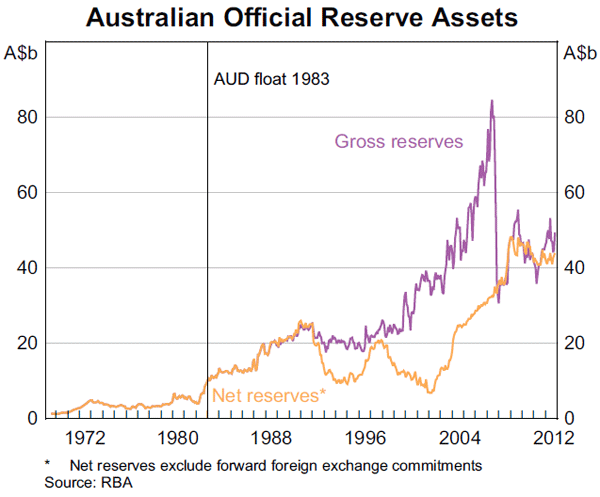
The Carrying Cost of Reserves
The method of acquiring reserves also has implications for the cost of carrying reserves, which is the difference between the interest rate received on reserve assets and the (generally higher) interest rate paid on the liabilities that fund reserves (or the return foregone on alternative assets). While uncovered interest parity predicts that any domestic and foreign interest rate differential will be offset by a change in the relative value of two currencies, the timing of such a change is unpredictable, and indeed may not eventuate.
For highly rated borrowers such as Australia, acquiring hedged reserves by borrowing foreign currency generally results in the lowest marginal cost of carrying reserves. When financed by issuing foreign currency securities, the carrying cost consists of the credit and liquidity premiums paid over the yield on the foreign currency assets held (such as US Treasuries or German Bunds); plus a term premium if shorter-dated foreign currency assets (which are usually more liquid) are funded via longer-dated borrowings (in order to mitigate the refinancing risk). As a AAA-rated borrower, any credit premium paid by the Australian Government or the Bank would tend to be relatively low, while the term premium would reflect the difference in tenor of borrowing relative to reserve asset investments.
The marginal carrying cost of unhedged holdings, on the other hand, is the return forgone on alternative investment opportunities. For a central bank, including the Reserve Bank of Australia, this is generally the return available on government or other high-quality domestic securities (or, more typically, the repo rate earned from lending cash against these securities).[6] Australian domestic interest rates, including short-term rates, have tended to be higher than those of the major reserve currencies. This results in negative carry from holding reserves over the long run, a feature common to many countries that maintain unhedged foreign exchange reserves.
Balance Sheet Implications of Reserve Assets
A corollary of an unhedged foreign exchange position is an exposure to fluctuations in exchange rates. As the Bank reports its financial performance and position (and pays dividends to the Australian Government) in Australian dollars, an appreciation of the Australian dollar results in a mark-to-market loss on foreign exchange holdings. The Bank also faces interest rate risk and credit risk, as the value of the foreign securities it holds fluctuates according to changes in market yields and perceptions of credit quality. Since these risks cannot be hedged completely without undermining policy capacity and flexibility, uncertainty around the Bank's earnings tends to increase with larger holdings of reserve assets and/or greater volatility in the exchange rate. As a result, the Bank retains a capital buffer (known as the Reserve Bank Reserve Fund) to allow for fluctuations in the value of foreign currency holdings.[7]
Foreign exchange reserves have averaged a little under half the size of the Bank's balance sheet over the past half century (Graph 4). To put the sensitivity of the balance sheet to Australian dollar volatility in context, assuming reserve assets are 50 per cent of the balance sheet, a 10 per cent rise in the Australian dollar will result in a decline in the Bank's capital of 5 percentage points relative to (pre-appreciation) assets.
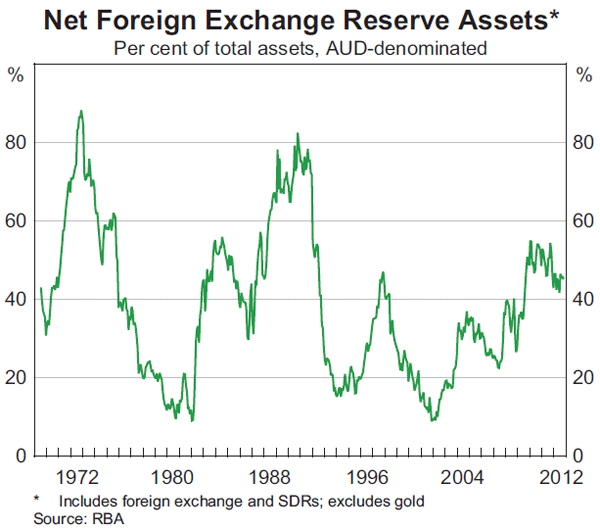
To some extent, interest earnings are available to offset these losses – a central bank pays no interest on many of its liabilities, but earns interest on its securities holdings. For the Bank, interest earnings on total assets have averaged around 4 per cent per annum since 1980 and have therefore helped to replenish capital over time, but earnings have sometimes been insufficient to cover the exchange rate losses that occurred in any one year.
Over the 2009/10 and 2010/11 financial years, the appreciation of the Australian dollar against reserve currencies resulted in cumulative valuation losses of A$9.6 billion, while a more stable Australian dollar in 2011/12 resulted in negligible valuation effects in that year. During this period, low yields globally caused underlying earnings from interest bearing assets to fall sharply, including on the Bank's domestic assets (Graph 5).[8] These developments resulted in a large decline in the Reserve Bank Reserve Fund as a share of the balance sheet (Graph 6). Reflecting this, a dividend was not paid to the Australian Government in 2009/10 or 2010/11 and a portion of the Bank's 2011/12 distributable earnings was retained by the Bank. This process of rebuilding capital is likely to be required for several more years.[9]
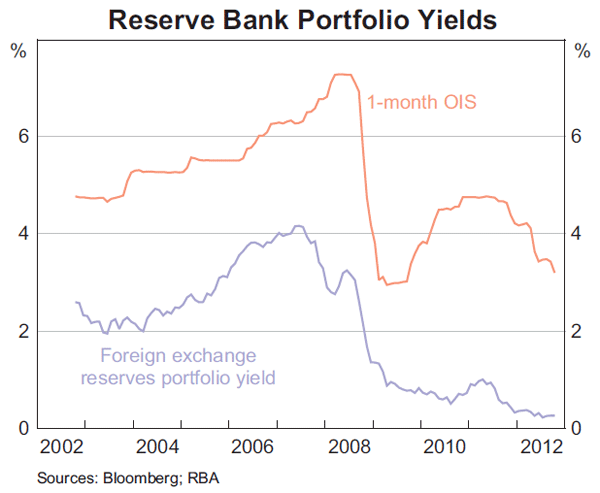
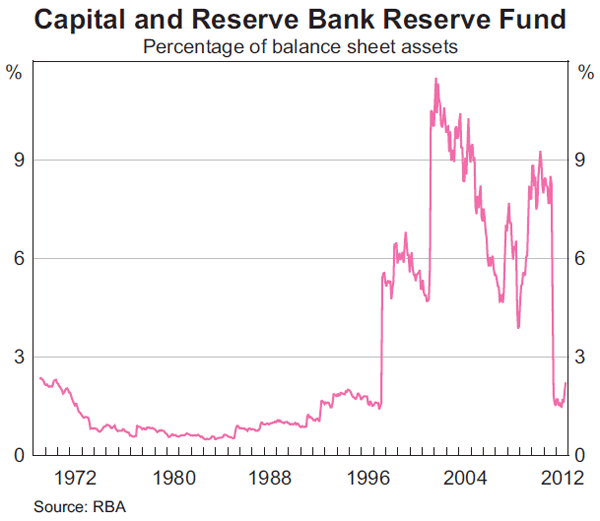
Risk Mitigation Strategies
Where possible, the Bank seeks to reduce the financial risks associated with its foreign exchange reserves. The most significant of these risks results from the volatility in the Australian dollar value of the reserve asset currencies. As the Bank's principal intervention currency is the US dollar, the reserve portfolio would consist almost entirely of US dollars were the Bank indifferent to the portfolio's risk-return performance. However, this is not the case, and the Bank therefore faces a trade-off between holding sufficient quantities of its primary intervention currency, and the increased risk from holding an undiversified portfolio.
As long as the returns on different assets and currencies are not perfectly correlated, a portfolio's risk-return profile improves with diversification. The Bank therefore seeks to mitigate currency risk and enhance risk-adjusted portfolio returns by holding several reserve currencies. Reserve currencies and their associated weights are selected based on an optimisation process involving several steps:
- The Bank first identifies eligible reserve currencies based on several criteria, including the ease of convertibility of the currency into US and/or Australian dollars, and whether the currency has underlying government bond markets that are sufficiently liquid for intervention purposes, and the sovereign issuer is of high credit quality.
- The Bank then defines its appetite for interest rate risk in each currency via shortfall analysis. This statistical process uses historical returns data to identify the duration for each currency portfolio that generates a non-negative return over a one-year horizon within a specified confidence interval.
- Given these preferences, the Bank undertakes a mean-variance optimisation process to generate an efficient frontier.
The efficient frontier represents combinations of currencies that maximise the portfolio return for a given level of risk (or, conversely, minimises risk for a given level of return). As a result of this process, the Bank has selected a portfolio that consists of US dollars (45 per cent), euros (45 per cent), yen (5 per cent) and Canadian dollars (5 per cent) (Graph 7).[10] This portfolio has inherently superior expected return and risk characteristics than a portfolio invested exclusively in US dollars.
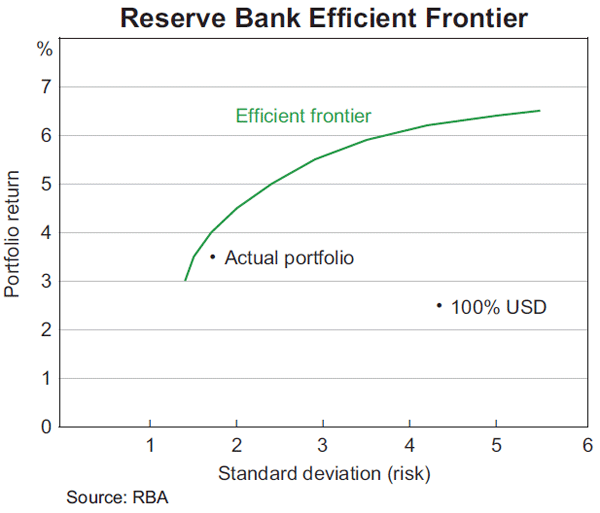
Determining the Appropriate Level of Reserves
In light of the above considerations, the optimal level of reserves can be considered as that which enables sufficient capacity to mitigate economic and financial shocks, while minimising the opportunity costs and risk exposures that reserve assets generate.
While accumulating reserves beyond this level may be beneficial in the sense that they increase the extent to which the Bank can respond to financial shocks, benefits accrue at a diminishing rate, and may not cover the cost of carrying reserves.
The trade-off between policy capacity and balance sheet risk is not a static concept, as risks to the central bank balance sheet fluctuate with changes in the exchange rate. When the exchange rate is especially low, the Bank is more exposed to financial loss from an appreciation in the domestic currency. However, as a mitigating factor, the Bank's holdings of reserves are also likely to be low around that time. When the exchange rate is especially high, the Bank can accumulate reserves most cheaply, and with the least risk to its balance sheet.
Each country will assess its needs for reserves differently based on their individual circumstances. Some well-known rules of thumb, such as the ratio of reserves to imports or reserves to short-term external liabilities, have been used to define the optimal level of reserves. More recently, considerable work has been undertaken, much of it by the IMF, to establish a more comprehensive framework to assess the adequacy of reserves that captures external vulnerabilities on the one hand, and incorporates policies that reduce the need for reserves on the other. While reserves provide self-insurance against external shocks, and countries with a higher level of reserves have generally been found to fare better during economic and financial crises, the first best line of defence is developed and flexible financial markets (including a free-floating currency), robust policy frameworks, and strong regulatory and institutional arrangements.[11] Australia has been well served by its existing policies and institutions, and this proved to be the case during the 2008 financial crisis.
More recently, the extent to which reserves were deployed by many countries for financial stability imperatives during the global financial crisis has influenced the reserves adequacy debate. Some advanced countries, with their large and globally integrated banking systems, have had to reassess their reserves in this context. However, because banking assets in these economies are often several multiples of GDP, holding reserves against these contingencies is impractical. Also, in the wake of the global financial crisis, Australia has had to consider increased contingent calls on its foreign exchange reserve assets as part of its expanded lending commitments to the IMF.
Reflecting this myriad of competing issues, the Bank does not target a specific level of reserves based on any one metric. Instead, a number of factors are considered, including the level of the exchange rate and the state of the economy, turnover in foreign exchange markets, and the size of the Bank's balance sheet.
Conclusion
Foreign exchange reserves are an important policy tool in the Bank's armoury. The Bank holds a largely unhedged foreign exchange portfolio to maximise its capacity and flexibility to intervene, but this entails risks to the balance sheet stemming from swings in financial market prices. The Bank seeks to mitigate these risks, chiefly by holding a diversified portfolio of currencies. The current level of reserves is judged to be sufficient for achieving the Bank's policy objectives in the current environment, particularly as Australia also enjoys robust and credible institutional frameworks and flexible markets that help mitigate the effect of economic and financial shocks.
Footnotes
The author commenced this work in International Department. [*]
The Bank publishes a detailed review of its foreign exchange operations in its Annual Report each year. [1]
For more information on the relationship between the Australian Government, the Reserve Bank of Australia and the IMF, see Poole (2012). [2]
For more information on the Bank's open market operations, see <http://www.rba.gov.au/mkt-operations/>. [3]
Countries with borrowed reserves typically issue foreign currency securities with maturities of three to five years. [4]
For a long-run time series of the components of the Bank's official reserve assets and transactions in the foreign exchange market, see statistical Table A4, available at <http://www.rba.gov.au/statistics/tables/#money_credit>. [5]
This is a result of the mechanics of the Bank's liquidity management practices: to manage domestic liquidity and target the cash rate, the Bank usually purchases securities under short-term repo each day to inject liquidity into the system. Purchases of foreign exchange by the Bank with Australian dollars increase system liquidity and reduce the daily deficit. This reduces the amount of cash the Bank needs to lend to the system, the return on which is the opportunity cost of the foreign currency. [6]
As at 30 June 2012, the Reserve Bank Reserve Fund stood at A$1.9 billion. See RBA (2012, p 89) for more details. [7]
The Bank lends most of its domestic assets to the market under short-term repurchase operations, and so the 1-month OIS rate serves as a proxy for the average repo rate on the Bank's domestic portfolio. [8]
See ‘Governor's Foreword’ in RBA (2012, pp 1–2). [9]
The Bank's actual portfolio sits slightly inside the efficient frontier as the Bank overlays the statistical analysis with subjective considerations to arrive at the final set of weights. [10]
See, for example, Moghadam, Ostry and Sheehy (2011). [11]
References
Becker C and M Sinclair (2004), ‘Profitability of Reserve Bank Foreign Exchange Operations: Twenty Years After the Float’, RBA Research Discussion Paper No 2004-06.
Moghadam R, JD Ostry and R Sheehy (2011), ‘Assessing Reserve Adequacy’, IMF Policy Papers, 14 February.
Newman V, C Potter and M Wright (2011), ‘Foreign Exchange Market Intervention’, RBA Bulletin, December, pp 67–76.
Poole E (2012), ‘Australia's Financial Relationship with the International Monetary Fund’, RBA Bulletin, December, pp 65–71.